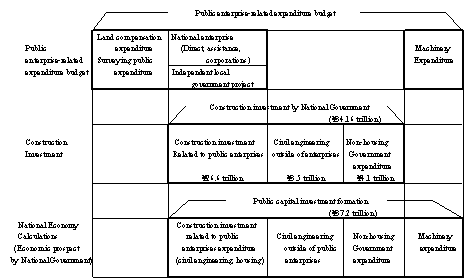| Construction Types |
Contents |
| 1.Total of Civil Engineering |
Total of civil engineering work in 2 - 15 below. |
| |
2.Erosion and Flood Control |
River control work, multipurpose dam construction, erosion flood control dam construction,
forestation, seashore protection and anti-erosion work. |
| 3.Agriculture, Forestry, and Fishery |
Construction work on agricultural roads, land, grass land, and facilities, work related to
cultivation and reclaiming land, construction of logging road, and construction related to fishing port, fishery, and fish cultivation
facility. |
| 4.Roads |
Road construction. |
| 5.Ports and Airports |
Construction of harbors, ports, and airports. |
| 6.Sewerage |
Sewage-related construction. |
| 7.Parks |
Construction of parks and athletic fields and facilities. |
| 8.Recovery from Disasters |
Construction work relating to recovery from disasters. |
| 9.Land Development |
Construction related to land development. |
| 10.Railways and Tracks |
Construction of railroads, tracks, automobile traffic facilities. |
| 11.Electric Power and Gas |
Construction of facilities for electric power and gas. |
| 12.City and Industrial Water |
Construction related to water facilities for city and industrial water. |
| 13. Disposal of Waste |
Construction of facilities for disposal of waste. |
| 14.Maintenance and Repair |
Maintenance and repair work. |
| 15.Others |
Outdoor electrical and civil engineering work related to buildings.
(including postal work and machine installation.) |
| 16.Total of Building |
Total of building in 17 and 18. |
| |
17.Housing |
Construction of housing buildings and housing facilities. |
| 18.Others |
Construction of non-housing and related facilities. |

